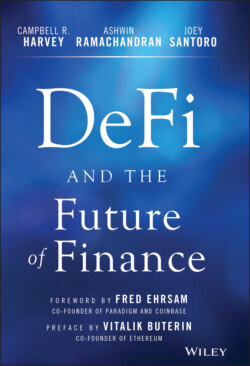Читать книгу DeFi and the Future of Finance - Campbell R. Harvey - Страница 9
FINTECH
ОглавлениеWhen costs are high, innovation will arise to capitalize on inefficiencies. Sometimes, however, a powerful layer of middle people can slow this process. An early example of decentralized finance emerged in the foreign currency (forex) market 20 years ago. At the time, large corporations used their investment banks to manage their forex needs. For example, a U.S.-based corporation might need €50 million at the end of September to make a payment on some goods purchased in Germany. Its bank would quote a rate for the transaction. At the same time, another client of the bank might need to sell €50 million at the end of September. The bank would quote a different rate. The difference in the rate is known as the spread – the profit the bank makes for being the intermediary. Given the multitrillion-dollar forex market, this was an important part of bank profits.
In early 2001, a fintech startup offered the following idea.2 Instead of individual corporations querying various banks to get the best rate, why not have an electronic system match the buyers and sellers directly at an agreed upon price and no spread? Indeed, the bank could offer this service to its own customers and collect a modest fee (compared with the spread). Furthermore, given that some customers deal with multiple banks, it would be possible to connect customers at all banks participating in the peer-to-peer network.
You can imagine the reception. The bank might say: “Are you telling me we should invest in an electronic system that will cannibalize our business and largely eliminate a very important profit center?” However, even 20 years ago, banks realized that their largest customers were very unhappy with the current system. As globalization surged, these customers faced unnecessary forex transactions costs.
An even earlier example was the rise of dark pool stock trading. In 1979, the U.S. Securities and Exchange Commission (SEC) instituted Rule 19c3, which allowed stocks listed on one exchange, such as the New York Stock Exchange (NYSE), to be traded off-exchange. Many large institutions moved their trading large blocks to these dark pools, where they traded peer to peer with far lower costs than traditional exchange-based trading.
The excessive costs of transacting has ushered in many fintech innovations. PayPal,3 founded more than 20 years ago, is a forerunner in the payments space; in 2017, seven of the largest U.S. banks added their own payment system called Zelle.4 An important commonality of these cost-reducing fintech advances is that they rely on the centralized backbone of the current financial infrastructure.
